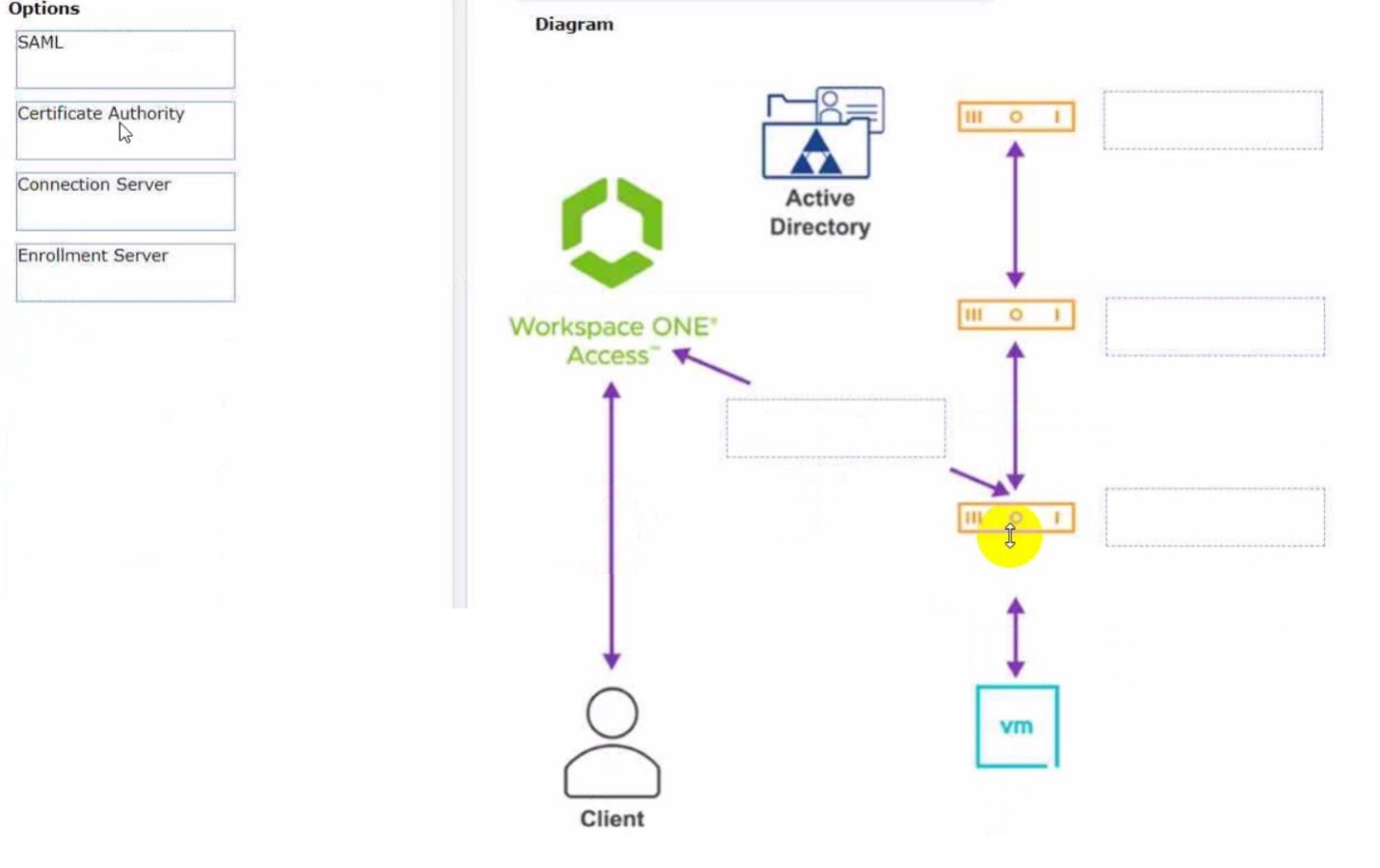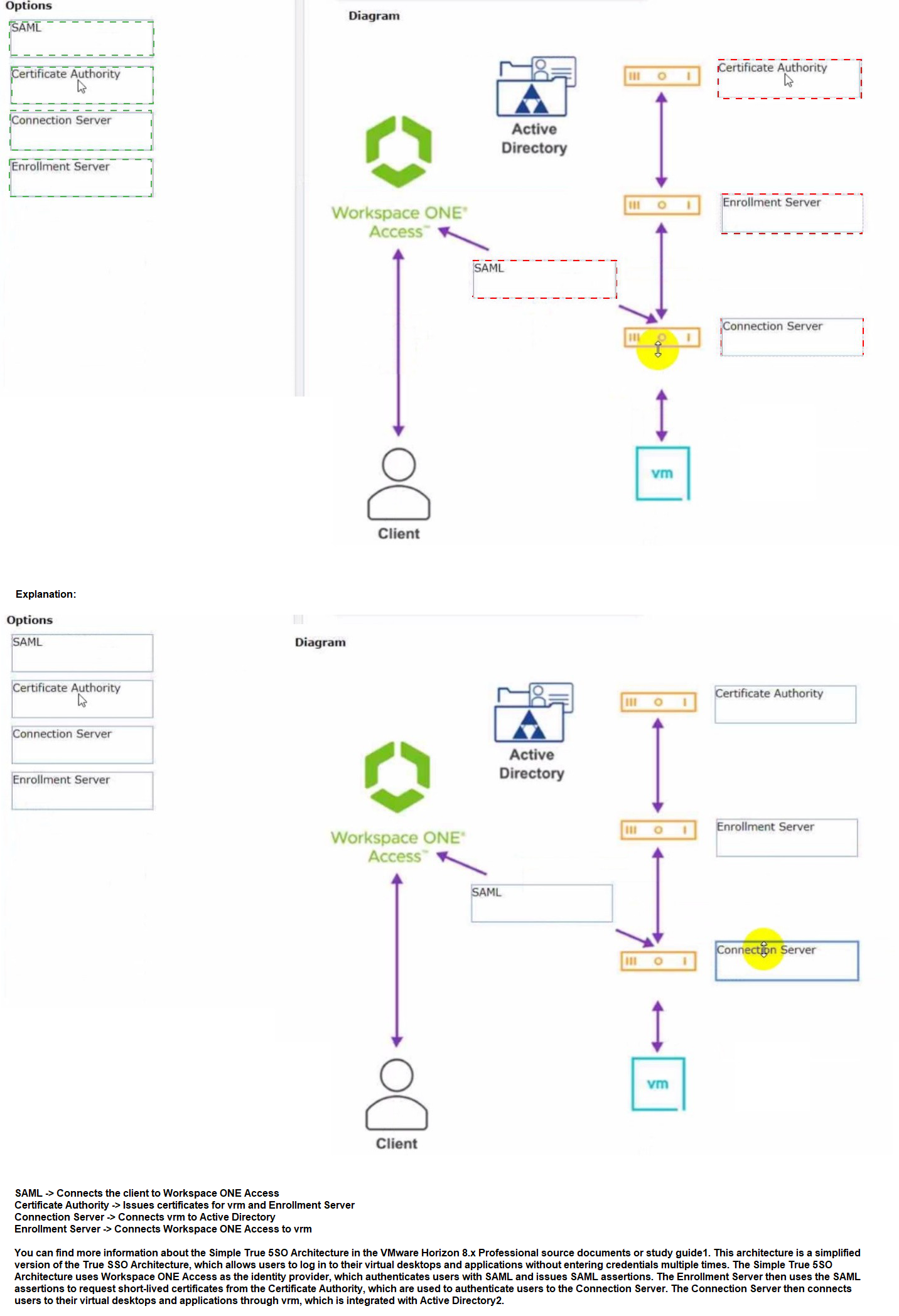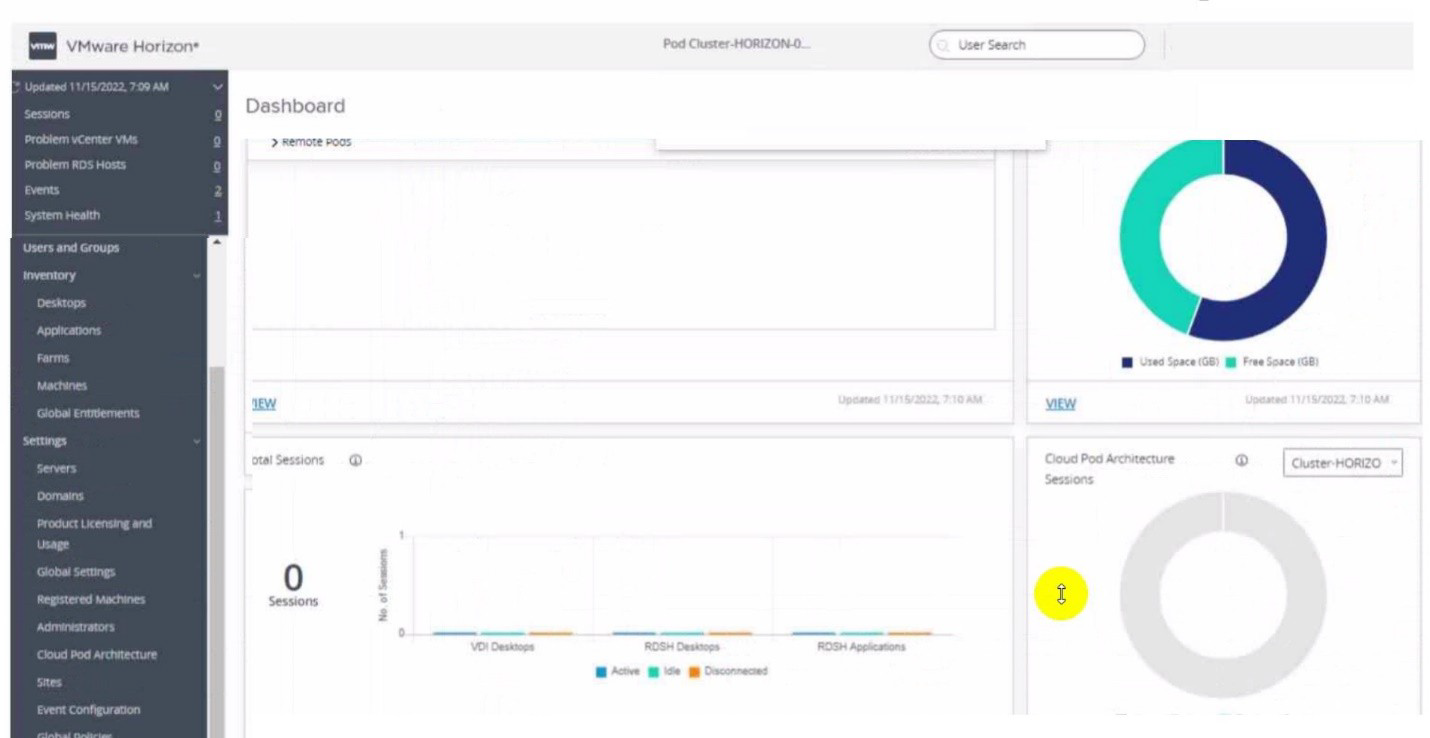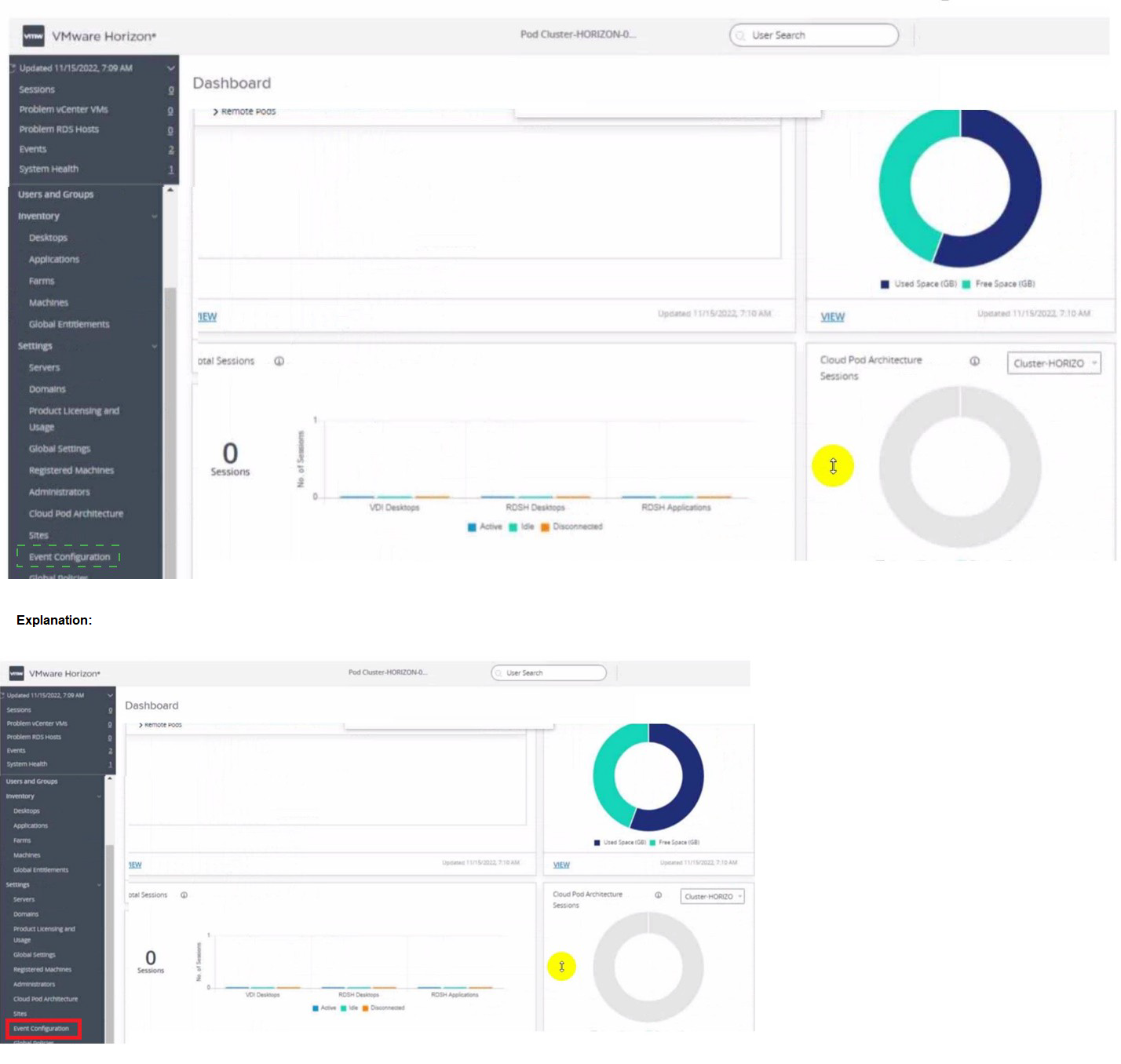
- Email support@dumps4free.com

Refer to the exhibit.
Drag and drop the correct options to build a Simple True 5SO Architecture on the left into
the diagram on the right.

Refer to the exhibit.
An administrator wants to configure a central SYSLOG server.
Mark the correct menu option by clicking on it.

Users need to be able to log into VMware Workspace ONE Access and connect to remote desktops and applications without having to provide Active Directory credentials. Which VMware Horizon component needs to be deployed to allow this functionality?
A. Replica Server
B. Security Server
C. Enrollment Server
D. vCenter Server
Explanation: The VMware Horizon component that needs to be deployed to allow users to
log into VMware Workspace ONE Access and connect to remote desktops and
applications without having to provide Active Directory credentials is the Enrollment
Server. The Enrollment Server is a standalone service that integrates with VMware
Workspace ONE Access and enables True Single Sign-On (SSO) for Horizon clients that
are using non-AD-based authentication methods such as RSA SecureID, RADIUS, or
SAML1. The Enrollment Server requests short-lived certificates on behalf of the users from
a certificate authority (CA), and these certificates are used for authentication to the Horizon
environment2. The Enrollment Server must be installed and configured in the same domain
or forest as the Connection Server, and it must have an enrollment agent certificate that
authorizes it to act as an enrollment agent2.
The other options are not valid or feasible because:
A Replica Server is a Connection Server instance that replicates the Horizon
LDAP configuration data from another Connection Server instance, and provides
high availability and load balancing for user connections3. A Replica Server does
not request or issue certificates for users, and it does not integrate with VMware
Workspace ONE Access.
A Security Server is a Connection Server instance that resides within a DMZ and
acts as a proxy for external user connections to the Horizon environment4. A
Security Server does not request or issue certificates for users, and it does not
integrate with VMware Workspace ONE Access. Security Servers are deprecated
in Horizon 8 and replaced by Unified Access Gateways (UAGs)4.
A vCenter Server is a management platform that provides centralized control and
visibility of vSphere hosts and virtual machines in the Horizon environment5. A
vCenter Server does not request or issue certificates for users, and it does not
integrate with VMware Workspace ONE Access.
A junior-level Horizon administrator is not able to see all RDS farms. Where would a high-level administrator need to make changes to correct the issue?
A. Category Folder
B. Access Groups
C. Global Entitlements
D. Global Policies
Explanation: Access groups are a way of organizing and delegating the administration of machines, desktop pools, application pools, and farms in Horizon. By default, all these objects reside in the root access group, which appears as / or Root (/) in Horizon Console. A high-level administrator can create sub-access groups under the root access group and assign different permissions to different administrators for each access group. For example, a high-level administrator can create an access group called RDS Farms and assign the Inventory Administrators role to a junior-level administrator for that access group. This way, the junior-level administrator can see and manage all the RDS farms that are in the RDS Farms access group, but not the ones that are in other access groups or the root access group. Therefore, to correct the issue of a junior-level administrator not being able to see all RDS farms, a high-level administrator needs to make changes to the access groups and the permissions associated with them.
The administrator of Windows 10 desktops in a VMware Horizon environment needs to
build a new Windows 10 desktop pool. This new pool will be dedicated to training and
onboarding new employees. The administrator has created a shortcut on a test machine,
which has successfully opened the web browser to the on-boarding applications. After
deploying the new desktop pool across the company, the administrator notices that the
shortcut placed on desktops is not available to any other user connecting to the desktop
pool.
Which two options are available for the administrator to make this shortcut available to all
desktop pool users, while minimizing ongoing administrative effort, before updating the
desktop pool golden image? (Choose two.)
A. Copy the shortcut during user provisioning to a non-writeable App Volume.
B. Copy the shortcut to the Windows Default Domain Controller Policy.
C. Copy the shortcut to c:\users\Public\Desktop.
D. Configure a Shortcut with Horizon View Client.
E. Configure a Shortcut with DEM (Dynamic Environment Manager).
Explanation: The two options that are available for the administrator to make the shortcut
available to all desktop pool users, while minimizing ongoing administrative effort, before
updating the desktop pool golden image are:
Copy the shortcut to c:\users\Public\Desktop. This option will place the shortcut in
the public desktop folder, which is shared by all users who log on to the same
computer. The public desktop folder is normally a hidden folder, so the
administrator needs to enable the option to show hidden files and folders in File
Explorer1. This option does not require any additional software or configuration,
but it will only work for the existing desktops in the pool. If new desktops are added
or refreshed, the shortcut will not be copied automatically.
Configure a Shortcut with DEM (Dynamic Environment Manager). This option will
use the DEM console to create a shortcut configuration that will apply the shortcut
to the user’s desktop during logon2. The administrator needs to install and
configure DEM on the Horizon environment, and create a configuration share and
a profile archive share for storing the DEM settings3. This option requires more
initial setup, but it will work for any desktop in the pool, regardless of whether it is
new or refreshed. It also allows more flexibility and control over the shortcut
properties and conditions.
The other options are not valid or feasible because:
Copying the shortcut during user provisioning to a non-writeable App Volume will
not work because App Volumes are used to deliver applications, not
shortcuts. App Volumes are virtual disks that are attached to the virtual machines
at runtime, and they contain application files, registry entries, and settings4.
Copying a shortcut to an App Volume will not make it appear on the user’s
desktop.
Copying the shortcut to the Windows Default Domain Controller Policy will not
work because this policy is used to configure settings for domain controllers, not
desktops. The Default Domain Controller Policy is a Group Policy Object (GPO)
that is linked to the Domain Controllers organizational unit (OU) in Active Directory,
and it contains security settings that are applied to all domain controllers in the
domain5. Copying a shortcut to this policy will not affect any desktops in the
Horizon environment.
Configuring a Shortcut with Horizon View Client will not work because Horizon
View Client is used to connect to remote desktops and applications, not to create
shortcuts. Horizon View Client is a software application that runs on various
devices and platforms, and it allows users to access their virtual desktops and
applications through a secure connection6. Configuring a shortcut with Horizon
View Client will not make it appear on the user’s desktop.
| Page 1 out of 17 Pages |